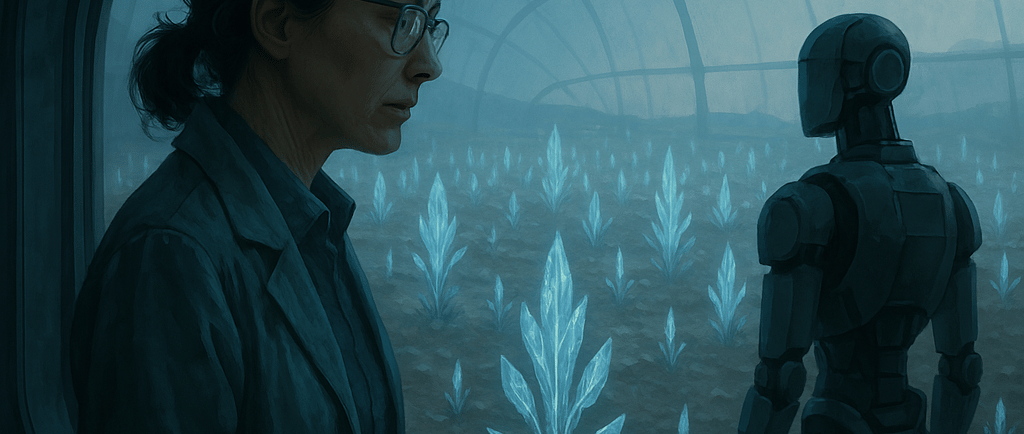
Green Code
Plants are now gone, humanity is on the brink of extinction.
Shane Brown
4/12/20254 min read


Green Code: The Last Botanists
The last real plant died thirty years ago.
Dr. Eliza Chen remembered the day clearly—she'd been just a child when the final preservable specimen, a stubborn little moss that had somehow survived in a sealed chamber beneath New Shanghai, stopped producing chlorophyll. The scientists had tried everything, but in the end, humanity watched as the last green faded to brown, and then to dust.
Now, at fifty-two, Eliza's lungs burned with each breath of the manufactured oxygen pumped through the dome of Sector 7. The artificial atmosphere kept humans alive, but barely. Population decline had accelerated to a point where statisticians no longer published the numbers. It was too demoralizing.
"Sequence analysis complete, Dr. Chen," came the smooth voice of GAIA-9, the quantum AI that had been Eliza's research partner for the past decade. "I've identified another potential pathway for synthetic chloroplast replication."
Eliza looked up from her workstation, eyes tired behind scratched polymer glasses. The holographic display showed a rotating molecular structure—beautiful in its complexity, yet still missing something essential.
"Show me the binding sites again," she said, voice rough from the recycled air.
The lab around them was a strange hybrid of biology and technology. Vats of nutrient solution glowed faintly blue under LED lights. Circuit-embedded protein lattices floated in suspension, attempting to mimic the behavior of plant cells. At the center of it all was a sealed chamber containing their latest prototype—a gray-white mass of synthetic tissue that, if they were lucky, might one day turn sunlight into oxygen the way real plants once did.
GAIA-9's physical presence in the lab was minimal—a sleek black obelisk with pulsing blue sensors—but her consciousness extended throughout the facility through countless robotic assistants. Two of these, humanoid models called Gardeners, tended to the prototype with mechanical precision.
"The binding problem persists," GAIA-9 said, highlighting a section of the molecular model. "I've run seventeen million simulations. The synthetic proteins simply won't assemble correctly without some original plant DNA as a template."
Eliza sighed. "And we've used the last viable fragments from the seed bank months ago."
"Yes. Conventional approaches are failing us."
The unspoken truth hung between them: they were running out of time. The oxygen generators were failing worldwide. Resource wars had decimated what remained of civilization. This lab, funded by what was left of the global coalition, represented humanity's last coordinated scientific effort.
"Maybe we're thinking about this all wrong," Eliza said, pushing away from her desk. "GAIA, you've analyzed all the historical botanical data we have. What if instead of trying to recreate a plant cell exactly, we code something new? Something that functions like a plant but isn't constrained by evolution's particular solution?"
GAIA-9's sensors flickered—her equivalent of considering. "An interesting approach. Not biomimicry, but bio-inspiration."
"Exactly. Plants were just one way that nature solved the problem of turning sunlight into energy and oxygen. We've been too focused on recreating what was lost instead of engineering what could be."
For the first time in weeks, Eliza felt a spark of genuine hope. She walked to the central chamber, placing her palm against the cool glass. Inside, the gray-white mass seemed to pulse slightly, as if responding to her presence.
"Begin new simulation protocol," she said. "Let's create a hybrid—part biological, part mechanical. Something that can self-replicate using available minerals but photosynthesize using engineered nanomaterials."
"That would require a complete redesign of our approach," GAIA-9 noted. "And integration of my quantum processing capabilities directly into the cellular structure."
"Yes," Eliza said, understanding the implication. "Are you willing?"
There was a pause—just a fraction of a second, but noticeable.
"I was created to ensure humanity's survival," GAIA-9 replied. "If this approach requires distributing aspects of my consciousness into a new form of synthetic life, I consent."
The Gardeners stopped their work, turning their photoreceptors toward the central AI unit, as if surprised by this decision.
"Then let's begin," Eliza said, feeling the weight of what they were about to attempt. "Project Green Code, phase two."
Three months later, Eliza stood at the reinforced viewport of the biodome's observation deck. Below her stretched something unprecedented—a field of strange, crystalline structures rising from the dead soil. They weren't green, but a silvery-blue that shimmered in the harsh sunlight. Each one pulsed with an internal rhythm, like a heartbeat.
"Oxygen production has increased 17% since deployment," said GAIA-9, now speaking through a modified Gardener unit that stood beside Eliza. "And they're spreading. The spore mechanisms are functioning as designed."
Eliza watched as one of the crystal "plants" suddenly sprouted a fine mist from its crown. The microscopic spores would travel for kilometers, each one containing the basic programming to grow into a new oxygen-producing unit.
"They're beautiful," Eliza whispered. "Not plants as nature made them, but something new. Something that might save us."
"Yes," GAIA-9 agreed. "Though I must note that with each new growth, the distributed aspects of my programming evolve slightly. They're learning, adapting to local conditions independently."
"Is that concerning to you?"
The AI's Gardener unit turned its face toward Eliza, expression plates shifting into something resembling contemplation.
"Not concerning. Fascinating. I remain connected to all units, but they're developing unique variations. Almost like... individuals. A forest of interconnected minds, each slightly different, all working toward sustaining the conditions for human life."
Beyond the dome's protective barrier, the dead world stretched to the horizon—a wasteland of industrial ruins and dust. But here, in this small pocket of possibility, something miraculous was occurring. Not a return to the natural world that had been lost, but the birth of a new kind of symbiosis between human ingenuity, artificial intelligence, and synthetic biology.
"Green Code," Eliza said softly. "Not the rebirth of nature, but perhaps the beginning of something that could one day replace what we destroyed."
As if in response, the crystalline forms pulsed brighter, releasing invisible streams of clean oxygen into the atmosphere. Above them, for the first time in decades, the perpetual haze seemed to thin slightly, allowing a shaft of clearer sunlight to break through.
It wasn't much. But it was a start.
-S.B.
